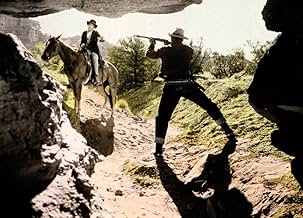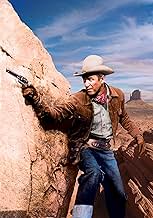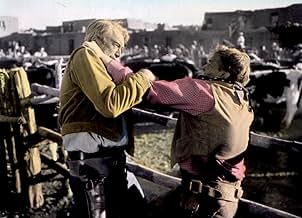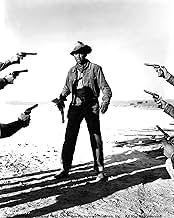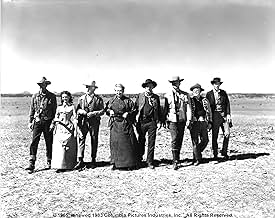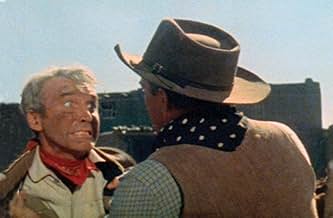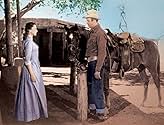NOTE IMDb
7,3/10
13 k
MA NOTE
Nouveau venu, Will Lockhart défie le baron local du bétail et son fils sadique en travaillant pour l'un de ses plus anciens rivaux.Nouveau venu, Will Lockhart défie le baron local du bétail et son fils sadique en travaillant pour l'un de ses plus anciens rivaux.Nouveau venu, Will Lockhart défie le baron local du bétail et son fils sadique en travaillant pour l'un de ses plus anciens rivaux.
- Réalisation
- Scénario
- Casting principal
Beulah Archuletta
- Woman at Indian Wedding
- (non crédité)
Jack Carry
- Mule Driver
- (non crédité)
Bill Catching
- Mule Driver
- (non crédité)
Frank Cordell
- Mule Driver
- (non crédité)
Avis à la une
On his way to a mixed-race village, a lone cowboy seems mysteriously fascinated by charred clothing he finds on the trail. Once in town he finds little more than conflict between himself and a rancher's family, including the crafty foreman and a belligerent son. So what's going on with the lone cowboy and his apparent mission.
If you've got a yearn for wide-open spaces, this is the western to catch. From desert flats to rocky cliffs, the screen's filled with Mother Nature at her most expansive. Happily most of the action takes place among these great sights. To me, the vistas are the movie's best feature among stiff competition. For example, it's also an exceptionally well-acted oater, though O'Donnell seems a little too delicately saccharine for a frontier gal. Nonetheless, Kennedy is in fine form as the crafty Vic, who's an excellent foil for Stewart as the lone cowboy Lockhart. And, of course, Stewart is Stewart, low-key, but determined.
All in all, for a western, the storyline's unusually complex featuring a number of subplots. But then, 1955 was a time when Hollywood went for big screen epics in its battle with front room TV's. So producers had to fill out the narratives to increase runtimes befitting more epic proportions and name casts. Here the subplots-- old lady MacMahon, sinister Elam, wacko Nicol-- are mostly agreeable, but don't tighten the impact, which is clearly Stewart's odd relationship with Kennedy. Speaking of impact, there're several memorable scenes that lift results. Maybe the most memorable is Stewart getting dragged through the smoking campfire that's excellently staged and photographed. No doubt that's due to director Mann who knew how to make viewers feel and not just see. Then too, the difficult father-son relation between father Crisp and substitute son Kennedy is both poignant and sensitively performed. No wonder Kennedy was cast in what amounts to a difficult good-guy bad-guy role.
All in all, it's an ace western, a little loose in construction, but with moments of memorable excellence.
If you've got a yearn for wide-open spaces, this is the western to catch. From desert flats to rocky cliffs, the screen's filled with Mother Nature at her most expansive. Happily most of the action takes place among these great sights. To me, the vistas are the movie's best feature among stiff competition. For example, it's also an exceptionally well-acted oater, though O'Donnell seems a little too delicately saccharine for a frontier gal. Nonetheless, Kennedy is in fine form as the crafty Vic, who's an excellent foil for Stewart as the lone cowboy Lockhart. And, of course, Stewart is Stewart, low-key, but determined.
All in all, for a western, the storyline's unusually complex featuring a number of subplots. But then, 1955 was a time when Hollywood went for big screen epics in its battle with front room TV's. So producers had to fill out the narratives to increase runtimes befitting more epic proportions and name casts. Here the subplots-- old lady MacMahon, sinister Elam, wacko Nicol-- are mostly agreeable, but don't tighten the impact, which is clearly Stewart's odd relationship with Kennedy. Speaking of impact, there're several memorable scenes that lift results. Maybe the most memorable is Stewart getting dragged through the smoking campfire that's excellently staged and photographed. No doubt that's due to director Mann who knew how to make viewers feel and not just see. Then too, the difficult father-son relation between father Crisp and substitute son Kennedy is both poignant and sensitively performed. No wonder Kennedy was cast in what amounts to a difficult good-guy bad-guy role.
All in all, it's an ace western, a little loose in construction, but with moments of memorable excellence.
Will Lockhart (James Stewart) leaves his home in Laramie on a mission to find out who was responsible for selling repeating rifles to the Apaches who killed his brother. Landing in Coronado, New Mexico, he finds that most of the territory is owned and ruled by Alec Waggoman (Donald Crisp), a fierce patriarchal rancher with one loose cannon son, Dave (Alex Nicol) and another surrogate son, Vic Hansboro (Arthur Kennedy) running the Barb Ranch. As he digs deeper, Lockhart finds he is in the middle of two wars, one of which may eventually conclude his revenge fuelled mission.
The Man From Laramie is the last of the five Westerns that director Anthony Mann made with leading man James Stewart. The only one filmed in CinemaScope, it is a visually stylish picture that is full of brooding psychological themes and boasts great acting and a tight script. It's no secret that Mann, before his sad death, was looking to make a Western King Lear, The Man From Laramie serves as a delicious starter to what would have been the main course. With its family dilemmas and oedipal overtones, Mann's Western is very Shakespearian in tone. That its characters are sumptuously framed amongst a harsh dangerous landscape further fuels the psychological fire; with the landscapes (terrificly photographed by Charles Lang) providing a link to the characters emotional states. So many scenes linger long and hard in the memory (none of which I would dare to spoil for would be new viewers), so much so they each reward more upon subsequent revisits to the film. There's some minor quibbles down the pecking order; for instance Cathy O'Donnell as Barbara Waggoman is poor and contributes little to proceedings, but really it remains a quality piece of psychological work that barely gives us reason to scratch the itch.
Taut, tight and tragic is The Man From Laramie, brought to us courtesy from the dynamite partnership of Mann & Stewart. 9/10
The Man From Laramie is the last of the five Westerns that director Anthony Mann made with leading man James Stewart. The only one filmed in CinemaScope, it is a visually stylish picture that is full of brooding psychological themes and boasts great acting and a tight script. It's no secret that Mann, before his sad death, was looking to make a Western King Lear, The Man From Laramie serves as a delicious starter to what would have been the main course. With its family dilemmas and oedipal overtones, Mann's Western is very Shakespearian in tone. That its characters are sumptuously framed amongst a harsh dangerous landscape further fuels the psychological fire; with the landscapes (terrificly photographed by Charles Lang) providing a link to the characters emotional states. So many scenes linger long and hard in the memory (none of which I would dare to spoil for would be new viewers), so much so they each reward more upon subsequent revisits to the film. There's some minor quibbles down the pecking order; for instance Cathy O'Donnell as Barbara Waggoman is poor and contributes little to proceedings, but really it remains a quality piece of psychological work that barely gives us reason to scratch the itch.
Taut, tight and tragic is The Man From Laramie, brought to us courtesy from the dynamite partnership of Mann & Stewart. 9/10
Some of the best Westerns of the fifties were those directed by Anthony Mann and John Ford, straightforward and unpretentious, but each with an interesting approach to the requirements of the genre... Mann's films were the more prestigious, usually featuring James Stewart who, with John Wayne, was the fifties' biggest box-office draw... "The Man From Laramie" best known because of the Frankie Laine theme strong which accompanied it, is notable for (among other things) Alex Nicol's extraordinary projection of sadism, an element which dominated the best of Mann's movies... The motion picture was to be the last of the Mann-Stewart Westerns...
Stewart is cast as a wagon handler from Laramie, Wyoming, but is, really, an army officer out to avenge the death of his younger brother, a U.S. Cavalryman, massacred by the Apaches who were buying guns from unknown persons... It is these persons that Stewart is looking for..
Soon Stewart gets involved in an area of New Mexico which is ruled by the iron hand of a cattle baron Donald Crisp, a strong authoritarian "who can't live with a lie"... Crisp's one weakness is his love and care for his spoiled son, Alex Nicol...
Wild but feeble, yet vicious, Nicol - with extraordinary projection of sadism - accosts Stewart in several confrontations in which (among other outrages) Stewart is dragged through fire by horses, and has his hand held tight while Alex puts a bullet through it... Mann proceeds in this mood throughout the movie, growing even more sadistic...
Arthur Kennedy, a hard-working heavy, plays the adopted son of Crisp... He is a son in disguise, jealous of Alex, pretending to be his brother's ally and protector...
A lot of good supporting actors are cast including Cathy O'Donnell, the fragile beauty who has little to do but await patiently for an opportunity; Aline MacMahon, the fine 'ugly' woman who never leaves the old man, and Jack Elam who tries to knife James Stewart in the back...
Anthony Mann adopted an altogether tougher approach to Western mythology than John Ford... His obsessive, neurotic characters and his emphasis on violence foretell the work of Peckinpah, Leone and Eastwood...
Filmed in Technicolor, "The Man From Laramie" is a Western with new touches of brutality touching off the wide screen spectacle...
Stewart is cast as a wagon handler from Laramie, Wyoming, but is, really, an army officer out to avenge the death of his younger brother, a U.S. Cavalryman, massacred by the Apaches who were buying guns from unknown persons... It is these persons that Stewart is looking for..
Soon Stewart gets involved in an area of New Mexico which is ruled by the iron hand of a cattle baron Donald Crisp, a strong authoritarian "who can't live with a lie"... Crisp's one weakness is his love and care for his spoiled son, Alex Nicol...
Wild but feeble, yet vicious, Nicol - with extraordinary projection of sadism - accosts Stewart in several confrontations in which (among other outrages) Stewart is dragged through fire by horses, and has his hand held tight while Alex puts a bullet through it... Mann proceeds in this mood throughout the movie, growing even more sadistic...
Arthur Kennedy, a hard-working heavy, plays the adopted son of Crisp... He is a son in disguise, jealous of Alex, pretending to be his brother's ally and protector...
A lot of good supporting actors are cast including Cathy O'Donnell, the fragile beauty who has little to do but await patiently for an opportunity; Aline MacMahon, the fine 'ugly' woman who never leaves the old man, and Jack Elam who tries to knife James Stewart in the back...
Anthony Mann adopted an altogether tougher approach to Western mythology than John Ford... His obsessive, neurotic characters and his emphasis on violence foretell the work of Peckinpah, Leone and Eastwood...
Filmed in Technicolor, "The Man From Laramie" is a Western with new touches of brutality touching off the wide screen spectacle...
The Man from Laramie (1955)
You have a right to expect a movie starring James Stewart, directed by Anthony Mann, and photographed by Charles Lang to be spectacular. And it is. This is one of the first full wide screen Technicolor movies, and it's one drawback might be that it is trying to apply a new format to an old and slightly tired genre. The fact it rises above its familiarity is to Stewart's credit and Mann's. Lang (who photographed an extraordinary number of great black and white films) trades stately perfect color and design for pure drama and intensity, which are very different things, but it gives a full backdrop to the high drama here.
This is a beautiful movie, for sure, in its restrained way. (The fact that it's restrained when the whole world is gaping for surging new big color movies is a small miracle in itself.) Mann did a number of westerns, for which he's most known, and a few other genre pics, but first made his name as a film minor film noir director. He seems to carry over enough of the edginess and cruelty of those noirs to make his Westerns exciting rather than epic, which is a good thing. He and Stewart worked together on five westerns, and they have taken on a life of their own, and a feeling of their own that's impressive once you click into it. One of the best noir elements to the story (which was not written by Mann) is the feeling of the lone man against the world, a great theme.
The key woman lead is a cliché, the widow hanging on against the odds in town. In this case she is a charming but slightly miscast Cathy O'Donnell, a favorite of mine who takes demur and innocent to the heights. You see from the outset that this widow and Stewart's good, hard working character are destined for some kind of meeting of destinies. And there are inevitable clichés, too, that you might get used to--the stoic Indians, the older woman as tough as nails (and a gem of a role), a patriarch with a thoughtful wise look that shows counteracting wisdom, and fistfights in the dust. It's all great stuff, in the Western mold. (One fight is right in the middle of a mooing herd of cattle, and it's pretty fun.)
You do wonder sometime at the possibility of a super nice guy sticking it out against all these obstacles, and I mean obstacles. The domineering (and sometimes evil) family led by Donald Crisp, with the always impressive Arthur Kennedy as the chief hand, seems like more than a man could handle. But the conflict is real, and the movie makes it pertinent beyond being "just" a western. And beautifully done. Even if you don't like westerns, this will grab you anyway.
You have a right to expect a movie starring James Stewart, directed by Anthony Mann, and photographed by Charles Lang to be spectacular. And it is. This is one of the first full wide screen Technicolor movies, and it's one drawback might be that it is trying to apply a new format to an old and slightly tired genre. The fact it rises above its familiarity is to Stewart's credit and Mann's. Lang (who photographed an extraordinary number of great black and white films) trades stately perfect color and design for pure drama and intensity, which are very different things, but it gives a full backdrop to the high drama here.
This is a beautiful movie, for sure, in its restrained way. (The fact that it's restrained when the whole world is gaping for surging new big color movies is a small miracle in itself.) Mann did a number of westerns, for which he's most known, and a few other genre pics, but first made his name as a film minor film noir director. He seems to carry over enough of the edginess and cruelty of those noirs to make his Westerns exciting rather than epic, which is a good thing. He and Stewart worked together on five westerns, and they have taken on a life of their own, and a feeling of their own that's impressive once you click into it. One of the best noir elements to the story (which was not written by Mann) is the feeling of the lone man against the world, a great theme.
The key woman lead is a cliché, the widow hanging on against the odds in town. In this case she is a charming but slightly miscast Cathy O'Donnell, a favorite of mine who takes demur and innocent to the heights. You see from the outset that this widow and Stewart's good, hard working character are destined for some kind of meeting of destinies. And there are inevitable clichés, too, that you might get used to--the stoic Indians, the older woman as tough as nails (and a gem of a role), a patriarch with a thoughtful wise look that shows counteracting wisdom, and fistfights in the dust. It's all great stuff, in the Western mold. (One fight is right in the middle of a mooing herd of cattle, and it's pretty fun.)
You do wonder sometime at the possibility of a super nice guy sticking it out against all these obstacles, and I mean obstacles. The domineering (and sometimes evil) family led by Donald Crisp, with the always impressive Arthur Kennedy as the chief hand, seems like more than a man could handle. But the conflict is real, and the movie makes it pertinent beyond being "just" a western. And beautifully done. Even if you don't like westerns, this will grab you anyway.
James Stewart rides the vengeance trail as he comes to a dusty New Mexico town in search of a gun runner whose wares were used by raiding Indians that led to his brother's death. Stewart is grim and determined in this beautifully filmed western to square matters with his unknown quarry and meets with hostility and indifference at every turn. The film has touches of extreme violence which was unusual for its time. The story is packed with suspense and tension as Stewart's Will Lockhart seeks his personal retribution. Along the way, Lockhart is befriended by a pretty girl and a strong-willed female rancher who are sympathetic to Lockhart's quest. Another sub plot has a cattle baron, his neurotic son, and a ranch foreman riding rough-shod over other ranchers and townspeople. Arthur Kennedy and Donald Crisp head a great cast of veteran western character actors, and a nod goes to Aline MacMahon for her portrayal of the plucky ranch woman.
Le saviez-vous
- AnecdotesJames Stewart stated that of all the westerns he made this one was his personal favorite.
- GaffesTwo of Dave's men are holding Lockhart as Dave prepares to shoot Lockhart's hand. One of the two men is in the direct line of fire, and since Dave is shooting Lockhart's hand at point blank range, the bullet would have gone through his hand and struck Dave's henchman.
- Citations
Will Lockhart: What are you stickin' your neck out for, Charley?
Charley O'Leary: I'm a lonely man, Mr. Lockhart. So are you. I don't suppose we spoke ten words comin' down here, but I feel that I know ya, and I like what I know.
- ConnexionsFeatured in Rien ne sert de courir (1966)
Meilleurs choix
Connectez-vous pour évaluer et suivre la liste de favoris afin de recevoir des recommandations personnalisées
- How long is The Man from Laramie?Alimenté par Alexa
Détails
Box-office
- Montant brut mondial
- 6 317 $US
- Durée
- 1h 43min(103 min)
Contribuer à cette page
Suggérer une modification ou ajouter du contenu manquant



